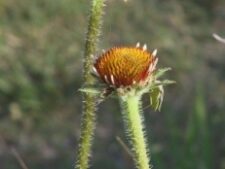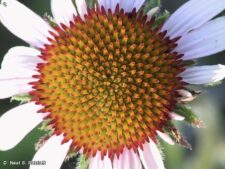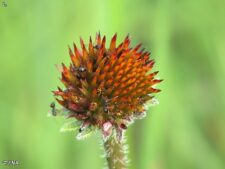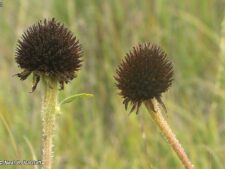
NARROW-LEAVED PURPLE CONEFLOWER
Echinacea angustifolia
SUNFLOWER FAMILY (Asteraceae)
 Identification
Identification
- Flowering time - June, July
- Uncommon in prairies at NW
- Short (less than 1 1/2 inch) ray florets
- Dome-shaped, spiny central disk
- Narrow leaves with smooth margins
This native perennial has upright stems 1-2 feet tall covered with short, bristly hairs (A,B). Narrow, prominently veined basal leaves are up to 10 inches long and less than 2 inches wide (A). The alternate upper leaves become scarce and progressively smaller above. Single flower heads at the top of the stem have pale pink to pale purple, spreading, infertile petal-like ray florets up to 1 1/2 inches long. They surround a reddish-brown central disk of fertile florets with yellow pollen (C,D) and prominent sharp-tipped bracts which persist long after flowering (E).
Grows on drier, well-drained soils in upland prairie sites, flowering in June and July. At Neale Woods, it is uncommon in the Jonas and Hilltop Prairie restorations. It has not been seen recently at Fontenelle Forest.
Narrow-leaved Purple Coneflower is one of three species found in our Neale Woods prairie restorations and the only one native to our virgin prairies in the area. Closely related Pale Purple Coneflower (E. pallida), native to prairies just to our east shares many characteristics, but is generally taller with longer, narrower, drooping ray florets and white pollen. A third species known simply as Purple Coneflower (E. purpurea), native to moister prairies far to our east, is the most common species in Neale Woods prairies and is the only one present in the Fontenelle Forest restorations. It has a bushier look with broader, toothed, lance-shaped leaves and showier dark pink to purplish ray florets.
Dinsmore, in his book indicates its importance to Native Americans. He writes that it “seems to have been used as a remedy for more ailments than any other plant” most notably for snake bites and other venomous bites and stings. It has also been widely used by herbalists, touted particularly for its anti-inflammatory and immunity boosting properties.
An alternate common name is Black Samson.
The content of NatureSearch is provided by dedicated volunteer Naturalists of Fontenelle Forest who strive to provide the most accurate information available. Contributors of the images retain their copyrights. The point of contact for this page is: Neal Ratzlaff.




